 One of the best (and scariest) things about Twitter is the instant feedback. I have posted all kinds of historical titbits, which have led to some fairly heated debates in the Twittersphere. But, no subject (not gay marriage, abortion, adultery or even Trump) causes the inflamed reactions that pubic hair does. It is inevitable, whenever I post an image of a woman with a full bush an argument ensues. Interestingly, no one has ever commented on the state of a gentleman’s manscape as long as I have been tweeting them; but, a woman’s knicker whiskers will upset someone every time. But, let’s be clear about one thing, this article is not pushing you to cultivate a full thatch, nor am I going to recommend fashioning yourself after an eel and marinating in a bathtub of veet. Whatever the hell you want to do to your own body hair is entirely your choice; wax the lot off and decorate your pubis with macaroni pasta and sparkles, or weave dreadlocks and have them hanging down your leg. It’s your hair and I fully support whatever you want to do with. But, here is what I do want you to think about; when did we get to the point when our own body hair is alien to us? When did we get to the point when pubic hair is called ‘disgusting’ or ‘gross’? Because this is always the cause of the arguments; someone recoils in horror at the sight of a woman with pubic hair you could wipe your feet on, and voices this online. Having a ‘type’ is one thing, but this voicing usually goes well beyond expressing a personal preference, and marches straight into outright revulsion at the prospect of a lady garden gone to seed.  When did this happen? When did our body hair, hair we have all got, hair that is supposed to be there, elicit the same levels of disgust as a matted hairball bunging up the plughole? It gets even stranger when you consider that a mere two-foot north of the offending silent beard is another crop of hair that we collectively devote billions of pounds every year to styling. A cursory glance at any hair style magazine reveals adjectives such as ‘glamorous’, ‘sultry’, ‘flowing’ and ‘luxurious’ being used to describe a mop that top and tails another barnet capable of making adults wince. Again, I am not trying to convince you to allow your squirrel to go feral, but I do want to pause on this issue and ask why have we become so anti-fuzz? To the point its regarded as un natural or ‘gross’? Because, that’s where we currently are; our own bodies revolt us, and we shame people for having hair that we have too! So where did all this start? 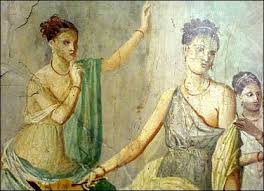 Many have pinned our plucking obsession on the Sex in the City Phenomena, and there may indeed be some truth to this; but, removing body hair goes back much further than Carrie Bradshaw discussing Brazilians over cocktails with the girls. The earliest solid evidence we have of hair removal comes from ancient Egypt and Mesopotamia. I say solid, because it has been speculated that prehistoric man would have managed his beard and hair – but, without unearthing a neo-lithic Gillette Mac Three, we are unlikely to be able to confirm this. Copper razors dating back to 3,000 B.C. were found among ruins in Egypt and Mesopotamia; tweezers and pumice stones have been found in Egyptian tombs. This was done for reasons of aestheticism, but also for religious reasons; Ancient Egyptian priests shaved or depilated all over daily, so as to present a "pure" body before the Gods. Evidence of pubic hair removal becomes less patchy (if you’ll excuse the pun) in Ancient Greece and Rome. The Greek playwright Aristophanes (446 –386BC) wrote if women "pluck and trim [their] doorways like good spiders; the flies come strolling in." Aristophanes also suggested that Greek men singed their briar patches off with lamp oil. The very wealthy Romans could even employ a picatrix, a young female slave whose job was to style her mistress's mop. But, we also have evidence that not everyone in the ancient world favoured the shaven haven. Graffiti written on the walls of the Roman city of Pompeii are the immortal lines "A hairy cunt is fucked much better than one which is smooth; it holds in the steam and wants cock". What this charming sentiment shouted at us from 79AD tells us, is that beneath the toga some women were smooth and some were hairy, and some were steaming (apparently). Of course, the Greeks and Romans were public bathers, so pubic hair styling was of some consequence; but the Beetle bonnet seems to have fallen out of favour in the middle ages. The supreme beauty for the medieval women (in Europe, at least) was pale, smooth, slightly plump, with a high forehead and a shiny face; nowhere is a hairy Mary mentioned. But, frustratingly, references to removing hair to achieve this ideal are very rare in medieval texts. A notable exception is Trotula de Ruggiero's 11th century treatise, De Ornatu Mulierum (About Women’s Cosmetics) includes this entry: ‘In order permanently to remove hair. Take ants' eggs, red orpiment, and gum of ivy, mix with vinegar, and rub the areas.’ As concepts of sexual sin changed, attitudes to pubic preening also changed, and hair removal came to be considered vain, and therefore sinful. In the medieval Confessionale, clergymen are encouraged to ask those who came to confession: ‘If she has plucked hair from her neck, or brows or beard for lavisciousness or to please men... This is a mortal sin unless she does so to remedy severe disfigurement or so as not to be looked down on by her husband.’ One of the most famous references to the gooseberry bush in medieval literature comes from Chaucer’s ‘The Miller’s Tale’ (1400). A love struck but simpering Parish clerk, Absolon, is in love with the miller’s super sexy, young wife, Alison (but she is having it away with her lodger, Nicolas). Abolson sings outside of her window, late at night and begs for a kiss. Intensely frustrated with his wooing, Alison sticks her ‘naked ers’ (arse) out the window, where, in the darkness, Absolon kisses ‘her hole’, believing it to be her mouth; he then jumps back having ‘felte a thyng al rough and long’. Disgusted, Absolon then begins to shout that ‘womman hath no berd’ (beard), and Alison and Nicholas fall about laughing ‘A berd! A berd!’ For Alison’s Brazilian blowout to be described as ‘rough and long’, like a ‘beard’, suggests this sex kitten does not favour the razor. Fifteenth-century Welsh poet Gwerful Mechain (1460–1502) wrote Cywydd y Cedor (”Ode to Pubic Hair”). It is an astonishing work where she criticizes 'Every foolish drunken poet' for heaping praise on all other parts of a woman apart from the 'court of fat’s plumage... the quim below the smock'. She tells poets to “let songs about the quim circulate,” and end with “lovely bush, God save it.” You can read the whole wondeful thing here. By the sixteenth century, texts that combined medical treatments with beauty treatments became increasingly popular. A 1532 beauty manual gives this recipe for a homemade depilatory cream: ‘Boil together a solution of one pint of arsenic and eighth of a pint of quicklime. Go to a baths or a hot room and smear medicine over the area to be depilated. When the skin feels hot, wash quickly with hot water so the flesh doesn’t come off.’ There is no detail on if this concoction was used on your sex thicket, but we all hope it was not. Francisco Delicado’s La Lozana Andaluza (1528) is about Roman sex worker, Lozana. She talks about sex workers ‘who pluck their eyebrows and others who shave their private parts’. She also recounts how she accidentally ‘burned off all the hair from the private parts of a lady from Bologna’ and healed it by salving it with butter. Whilst some women were obviously willing to souse their trouser sprouts in acid, the low toupee was seen by many Europeans as the must have sexual accessory. Slang terms for pubic hair from the Renaissance are overwhelmingly positive and include ‘feathers’, ‘fleece’, ‘flush’, moss’, ‘plush’, ‘plume’ and the ‘admired abode’. Shakespeare makes a number of bawdy pubic hair double entendres in his work, suggesting muff was de rigueur. In his Venus and Adonis, Shakespeare writes about ‘Sweet bottom-grass’ (my personal favourite) that lies between ‘Round rising hillocks’; in Much Ado About Nothing, Cupid is wryly referred to as a ‘good Hare finder’, and many have argued that the ‘black wires’ that grow upon the speaker’s mistress in ‘Sonnet 130’ is a not to subtle reference to the ladies' short and curlies. But, more than just being the norm, an abundant crop of parsley was a sign of health, youth and sexual vitality. The hero of Richard Head’s The English Rogue (1665) complains that an elderly woman he sleeps with had no pubic hair; ‘I apprehended my danger the greater because I found no rushes growing there, which is an observation of the people; judging the bog passable which hath such things growing there on.’ The Renaissance Brit, in particular, favoured a Hairy Potter. Spenser, in Strange and True Conference (1660) wonders as ‘the Spanish mode of shaving off all the wenches’ hairs off their commodities’. And, the Earl of Rochester declared ‘My prick no more to bald cunt shall resort’. Objections to sporting a Voldemort (a bald cunt) today almost always point out that only children have hairless genitals. But, this doesn't seem to have concerned the Elizabethans, they saw baldness as illness, rather than youth. The absence of a full, thick and luxurious bottom Barnet meant you were sick. One reason for mowing the lawn was pubic lice, which could only be got rid of by shaving; but, an even more unpleasant reason for malting muffs was syphilis. Syphilis was first recorded in Naples in 1495, and one of the many nasty symptoms of secondary stage syphilis is hair loss (head hair, eyebrows and pubic hair). Even though this is a rare symptom, the treatment for syphilis was mercury, which most certainly does cause hair loss. As a result, patchy pubes came to be regarded as a sign of disease; whereas we may view a snatch patch as ‘disgusting’, your Elizabethan lover would have viewed a bald eagle in very much the same way. In Thomas Middleton’s Trick to Catch the Old One (1605), a character called Audrey is attacked as an ‘unfeathered, cremitoried quean, you cullisance of scabiosity’. In Westminster Whore (1610), one ‘lascivious bitch’ is cursed to have ‘a cunt without hair and ten thousand poxes upon it’; and in Night Searches (1640), Mill describes whores who are ‘out of date, some tattered; some want a fleece, some a nose’. The narrator of a ‘Loose Song’ from 1650, refuses to have sex with a pubeless woman as ‘her stuff rustles like buff leather jerkin’.  If a lady had got to the point that a comb over was no longer disguising her tufty tuppence, she could always go for a pubic wig (merkin). The Oxford Companion to the Body points to 1450 as the year “malkin” — from which the name for a pubic hair wig derives — first appeared. Rochester complains the ‘Merkins rub off and spoil the sport’. Mentions of the merkin appears in numerous slang dictionaries from 1600s until the nineteenth century. The merkin is also mentioned in Alexander Smith’s A Complete History of the Lives and Robberies of the most Notorious Highwaymen (1714): “This put a strange Whim in his Head; which was to get the hairy circle of [a] prostitute’s Merkin…this he dry’d well, and comb’d out, and then return’d to the Cardinal, telling him he had brought St. Peter’s Beard.” 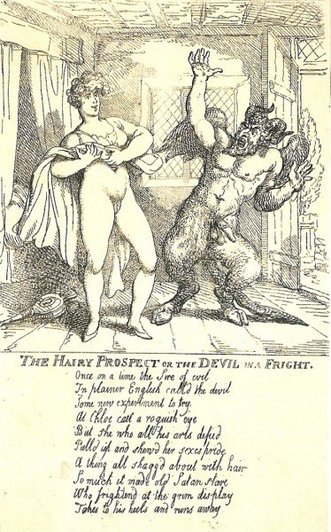 Though some ladies may have been wigging it, throughout the eighteenth century bush was most certainly meant lush. Despite the introduction of Jean-Jacques Perret’s safety razor in 1770, pubic hair was still associated with rude health. As the opposite pictures shows, it could even ward off the Devil. Harris’ List of Covent Garden Ladies (1857-1869), an almanac of sex workers available in London, is extremely positive about ‘the mossy grot’. Miss Devenport is described as being well thatched, ‘though not yet bushy, might truly be stiled Black Heath’; Miss Betsy has ‘ebony tendrils that play in wanton ringlets round the grot’, and Madam D—sl—z’s ‘lower tendrils, which sport on her alabaster mount of Venus, are formed to give delight’. Cleland’s heroine, Fanny Hill (1749), describes the ‘mossy mounts’ of her ‘soft laboratory of love’, and the ‘the curling hair that overspread’. She also admires her lover Phoebe, who ‘played and strove to twine in the young tendrils of that moss, which nature has contrived at once for use and ornament.’ Victorian erotica is also full of praise for the happy trail; in some cases, describing a ‘tuzy-muzy’ that, frankly, could scour a greasy pot clean. In Romance of Lust (1875), the hero Charlie Roberts describes many furry lovers and clearly finds body hair a turn on. "Her position brought out all the beauties of the vast wide-spread mass of black curly hair that thickly covered all the lower part of her magnificent quim, ran down each thigh, up between her buttocks, and opening out on her back, had two bunches just below the two beautiful dimples that were so charmingly developed below her waist. There was as much hair there as most women have on their mons Veneris. Her whole body had fine straight silky hair on it, very thick on the shoulders, arms and legs, with a beautiful creamy skin showing below. She was the hairiest woman I ever saw, which, doubtless, arose from or was the cause of her extraordinary lustful and luxurious temperament. The sight I was indulging in brought out my pego in full bloom; as we both rose she saw it sticking out under my shirt." In ‘The Sultan’s Reverie’ (1880), the beautiful Sultana is described as having ‘a splendid swelling mount an covered with long, black, curly hair, extending far over her beautiful belly, and some inches down on the inside of her thighs’.  Francisco Goya's The Nude Maja (1797) is considered to be the first European painting to show a female subject's pubic hair, but women in Victorian art were still depicted with featureless genitals. Indeed, it has been suggested that one of the reasons the famous art critic, John Ruskin, was unable to consummate his marriage to Euphemia Gray was because he was horrified to find that, unlike works of art, women have pubic hair. The marriage was never consummated and was eventually annulled; and the only clue we have has to why is in a letter written by Euphemia in 1848. "Finally, this last year he told me his true reason (and this to me is as villainous as all the rest), that he had imagined women were quite different to what he saw I was, and that the reason he did not make me his Wife is that he was disgusted with my person the first evening." Despite Ruskin’s anxieties, some Victorian women did practice hair removal, as shown in these pictures; we can even see some of the first ‘landing strips’.  The absence of the merkin suggests that a mowed lawn was coming back into fashion once more; or, at least it was no longer regarded as a symptom of disease. It seems likely that the retreat of pubic hair in the western world is linked to the emergence of photography and pornography. It is certainly linked to being ‘seen’. Roman and Greek women plucked their pudendum because nudity was commonplace, but as bodies were covered up and were called ‘sinful’, there were far fewer pussies on parade. With the advent of photography and film, genitals were once again, seen. Of course, you can look at your own unmentionables, maybe even your friends; but, there’s nothing quite like looking at a sexualised image of a stranger to have you doubting your own sex appeal. Fashion has certainly its part; the removal of underarm hair is directly linked to the new fashion for sleeveless dresses in the 1920s, and a cunning adverting campaign that told women they smelled bad. Leg shaving increased as skirt length decreased, and as underwear shrank to something you could floss with (hello G-String), love locks disappeared too. I’ve heard many times that the heyday of the bush was the 1960s and 70s, but this simply isn’t true. But, it was at this time, that porn started to become mainstream; the seventies are often referred to 'the golden age of porn'. It was not that the rug was back in fashion, it had never been out of fashion; we just saw more of it. And Of course the women were splendidly bewhiskered, no one had told them not to be. Pubic hair appeared for the first time in Penthouse in 1970. In 1974, Hustler published the first “pink shots” of labial flesh, but hair was still very much on the menu. By the mid-70s, Playboy’s circulation surpassed seven million. 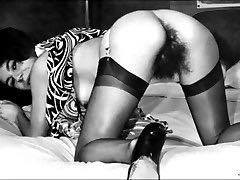 That pussy pelt has gone AWOL in recent years is often linked directly to pornography becoming mainstream; but, perhaps we should cast our nets a little wider than that. Yes, porn is far more accessible, but we are living in an image saturated society that constantly reinforces what is ‘normal’. It is not just porn that cue balls its women; toys, fashion magazines, newspapers, film, television, advertising, music videos, etc., will not show you a single trouser tendril (unless, it’s in an arty, subversive manner.) It’s like looking for a pube in a haystack. The reason people react so strongly to women with a cossack hat in her knickers is that they are not used to seeing it; it’s not their normal. The less we see it, the ‘weirder’ it looks when we do, and so the vicious, pubeless cycle continues. Bizarrely, our normal has become the images we see of nude bodies, rather than our own. Models, actors, pornstars, etc have come to mean 'normal' for the rest of us. One of the slightly more disturbing associations with pubic hair removal is hygiene. I hear that all the time; it’s just ‘cleaner’. Recent research carried out by University of California found that more than half of 3000 women surveyed groomed their pubic hair did so for hygiene reasons (despite evidence that shaving pubic hair can make the vagina more vulnerable to irritation and infection.) So, I’ll say this only once, if the hair on your head doesn’t make your scalp stink, pubic hair will not make your vulva ‘dirty’. Trim your bear skin however you want too, but you don't have to do it to be 'clean'. In recent years, there have been rumblings that the bush is on its way back. In 2014, American Apparel displayed mannequins with merkins in their New York flagship store. In 2016, society bible Tatler announced the ‘bush is back’. Caitlin Moran has declared that all women should have a “big, hairy muff”. Gwyneth Paltrow revealed that she “works a Seventies vibe”. I suspect that as more and more celebrities ‘normalise’ the mighty muff, it will become acceptable once more. Pubic hair is frequently placed on the frontline of feminism, and growing a new band member for ZZ Top in your pants is often seen as a fuzzy fuck you to the patriarchy that leaves you literally tearing your hair out. And, it is a statement. When reactions to the sight of body hair veer into revulsion, we have to ask, how free is the choice we make to pluck our pubes? When we run the risk of social shaming for not taming our trouser tresses, are we really doing this because we want too? The emphasis here is on choice, but in order to really have free choice, we can't judge someone else's choice to fluff it up. I hope this article has shown, fretting about the quality and quantity of your ‘mossy grot’ has a long, tangled history; so too does painful and dangerous methods of hair removal. But, for most of our collective history, pubic hair has not only been the norm, but regarded as sexy, healthy and luscious. So, whatever you want to do to yours, I promise, it’s all been done before. "Sultan of an ode, it is silk, little seam, curtain on a fine bright cunt, flaps in a place of greeting, the sour grove, it is full of love, very proud forest, faultless gift, tender frieze, fur of a fine pair of testicles, a girl’s thick grove, circle of precious greeting, lovely bush, God save it." Gwerful Mechain Cywydd y Cedor (”Ode to Pubic Hair”) 15th Century 1/7/2017 04:08:16 pm
Ladies of the night rarely have growth, which tends to focus ones attention on the pink purse. But I do like the hot and humid tuft, all wet and sticky and it's something extra to gently pull upon by manual or oral means for shared pleasures. Only drawback is the errant tongue pube.
Peter Jones
1/7/2017 04:24:38 pm
Great writing.
TM
1/7/2017 06:43:11 pm
As someone who hit puberty in the '80s, I am baffled by the disgust for women's pubic hair. There was a time when reaching that fuzzy place meant so much! It was the line between public and pubic, a sign that a partner had allowed you the most intimate access. Seeing it was the next level.
Tinkitten
1/8/2017 02:49:20 am
Love this. I felt from the age of 15 that it was the done thing to shave it all off and constantly had rashes and ingrown hairs, I was too soft to wax. But now 31 and a feminist am sick of having to adjust my body because men prefer it. I grew mine out about 6 months ago and feel much happier, it's cheaper without the razors and warmer! And my bf is happy whichever way I have it.
StrechyStace
1/8/2017 08:31:32 am
I am with you on this- 100%. I'm 30 now, but I was lead to believe that thatch was 'disgusting' by every boy I met from 15-25. I suffered all the same issues you mentioned here too, so I started to grow the landing strip but had to keep it short still for fear of that awful revulsion from male partners. Fortunately, by 26 I didn't give shit anymore and grew the entire thing out, with some trimming around the edges and I never looked back. If a man thinks it's horrible, I just don't care. I tell him that I don't like manscaping, bellyaching or griping so we are evidently incompatible. Viva la bush! 😁
strangefriend
1/29/2017 10:07:38 am
Sisters, the proper response to male revulsion to pubic hair is a taser.
L Walterson
2/1/2017 03:28:36 am
As a lover of femininity in all it's flowering , congrats on taking back your own sense of natural and romantic. I believe in choice in these matters- I just don't really get why anyone would think it dirty or unattractive. I think I will take a few minutes to copy this to a bunch of like-minded souls. Cc2
Larue Walterson
2/1/2017 03:26:17 am
As a lover of femininity in all it's flowering , congrats on taking back your own sense of natural and romantic. I believe in choice in these matters- I just don't really get why anyone would think it dirty or unattractive. I think I will take a few minutes to copy this to a bunch of like-minded souls.
Larry
9/17/2017 03:17:04 pm
Awesome Response!!!!
Ryan
1/8/2017 10:20:41 am
Great article, lthough I think it should be 'immortal' not 'immoral'!
Alan Test
1/8/2017 02:27:07 pm
The reason 70s porn was so hairy - in the UK at least - is that the interpretation of the Obscene Publications Act enforced by PC Plod defined visible labia as the point where illegality began. 1/8/2017 03:41:25 pm
This is a fantastic article! Thanks so much for putting it together, a great read <3 1/8/2017 06:13:12 pm
I love the sexy history lessons! Pubic hair is a strangely contentious field. One more battle humankind futilely rages against Nature... that bitch always wins. :) Thanks for sharing your excellent research with us!
Janine
1/8/2017 11:54:05 pm
Very interesting. But like other hair, pubes go grey, and though I believe you can buy 'betty hair' dye, the skin is very sensitive. So at that point, pubes become ageing and are likely to be removed for the same reasons people dye grey hair - a bush is one thing, but a brillo pad quite another.
Brian O'Neil
1/14/2017 09:12:06 am
First of all, I love your tweets 1/29/2017 07:02:10 am
Great article and thank you for the historical perspective. Excellent quote btw, I laughed hard "A hairy cunt is fucked much better than one which is smooth; it holds in the steam and wants cock" 1/30/2017 12:09:16 am
Dear Kate Lister
Kate
1/30/2017 03:00:40 pm
Hello there. Yes. I would be very happy for you to include it. Just drop me an email at [email protected] and we'll sort out the details. 3/2/2017 05:41:28 pm
C'est la vie, n'est-ce pas?
Reg
3/13/2017 06:09:18 am
I'm a man and I love pubic hair. What could be more erotic that touching the secret forest?
Ashley
4/18/2017 03:04:49 pm
This was SO GOOD! Seriously great overview. Also, you clearly had a lot of fun with all the phenomenal metaphors. I will say that I noticed a common feature among the Twitter responders who were so grossed out by women's pubic hair...
Julie
4/18/2017 03:26:39 pm
I started having sex in the 80's and apart from a little trim so that no hairs stuck out of the side of your knickers sported a full head of pubic hair, as did all my friends - boyfriends wouldn't dream of commenting because we all had pubic hair - relationships into the late 90's and still sported a full 'head' and boyfriends (later husband) made no comments - think it was about this time, 20 years ago that the bush disappeared. Porn showed naked vaginas and I have repeatedly said how unrealistic it is when teenage boys see this and expect girls to be naturally bare, so much pressure on girls. I really hope that this passing phase ends and girls reclaim their pubic hair, which has been eradicated by mens porn.
Feminist Without Apology
4/18/2017 03:27:40 pm
My brother has a scraggly beard and smokes (you can smell him when he walks into a room, and I imagine it is only concentrated in his beard). Yet he finds it inconceivable that a woman these days would have a full "70's style" (as he calls it) bush.
Andre Leonard
4/19/2017 12:04:43 am
"But, here is what I do want you to think about; when did we get to the point when our own body hair is alien to us? When did we get to the point when pubic hair is called ‘disgusting’ or ‘gross’?
Machined
5/11/2017 02:17:32 pm
Great read! I love the language :)
Steve Ballantyne
5/21/2017 12:37:47 am
"Malting muff"? "Moulting", surely?
Brianna
6/25/2017 01:22:07 am
At least you can change your mind with hair..it will grow back. The one that yanks my chain is labiaplasty. Men telling women that tbeir lips are gross. Making up insulting names like beef curtains. As if the scrotum is a lovely flower but the same flesh on a woman is yucky somehow.
Emily Toombs
6/27/2017 11:06:18 am
This is an absolutely fantastic insight into the bearded lady. Now my tale of woe starts at 13. I went with a friend and her father to a gym. I had only ever been a dancer so naturally I wore a leotard. Hey, the 80s. When walking in her dad proclaimed in front of everyone who could hear *pointing* that "your father should have told you woman shave that off". I had a few wispies peaking out the sides. I WAS 13. No my father wouldn't have dared to comment on his daughters pubic hair. Ever. I was mortified and could have died on the spot. No female dance instructor or gymnastics coach or figuring skating coach (of which I had all three) said anything ever. The damage was done. I absolutely didn't have the internet or nude magazines to fact check this 49 year old pussy peeker. So I shaved it. All of it as soon as I got home. I cried. I cut myself doing it with what was called a 'flicker' razor. Woman of a certain age will remember them. They're horrible and don't get the job done. It was all I had. I barely shaved my legs being very fair skinned and blond I had 'glitter' as stubble on a sunny day. Here I was butchering my pink parts because a man didn't like the fact A 13 year old GIRL didn't have her bikini lines shaved. In hindsight that is seriously fucked. However it's completely shaped my relationship with public hair since. I spent that summer scratching,rashes, and red bumped before my mother caught on and schooled me on the finer points of pubic trimming. Like don't shave it all off just shave the unsightly sides. Still as I got older the expectations of hair down there became have less and less. Trim the bikini, then a nice shaped bush to landing strip ended in bare down there. Hardwood floors are basically the male expectation now. Through porn that's what their told is sexy and attractive now. Full stop. However being in our gardens is a fucking privilege. You have been blessed that a woman has declared you "fit to pass" and you should count those blessings. If you're offended well I suggest you literally go fuck yourselves. Seriously, that's where the phrase derived from. Be it man or woman, because we're focused on men not liking the state of things south of but I know that this can't possibly be a male privilege. Again the media, porn included and especially dictates now what we as a society find appealing. So I fully expect this includes the LGBT community as well. I'd also love to hear about woman who like woman who like shaved woman exclusively, who don't like to shave themselves. That's a fascinating conversation. Personally, I will never shave for anyone again. It's just not worth the discomfort however sexy or not.
Suzanne Beauregard
8/24/2017 06:10:14 pm
I never knew there were so many great descriptive terms for a lady's parts.
Lady Redquim
8/25/2017 02:10:27 am
Luckily, I'm old enough to have come of age in the 60s, and hung out with hippies who didn't shave anything. I stopped shaving my underarms and legs after spending some time in Italy, and the only time my pubic hair was shaved was before a surgery. I thought it looked horrible bare, and growing it out was almost worse than the surgery! I don't have a lot of hair, but it's red...why would I want to remove red pubic hair? It's only ever been received with delight and sometimes astonishment!
Doug Ahart
9/7/2017 09:26:37 pm
A delightful presentation of a subject that I have long adored being a child of the 50s and 60s. Most do not realize how protective the "sweet grass" is to our skin which even the movement of clothing can takes its toll. thank you. Comments are closed.
|


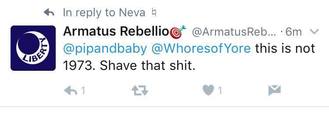


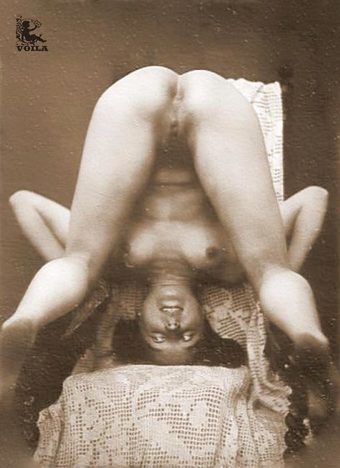

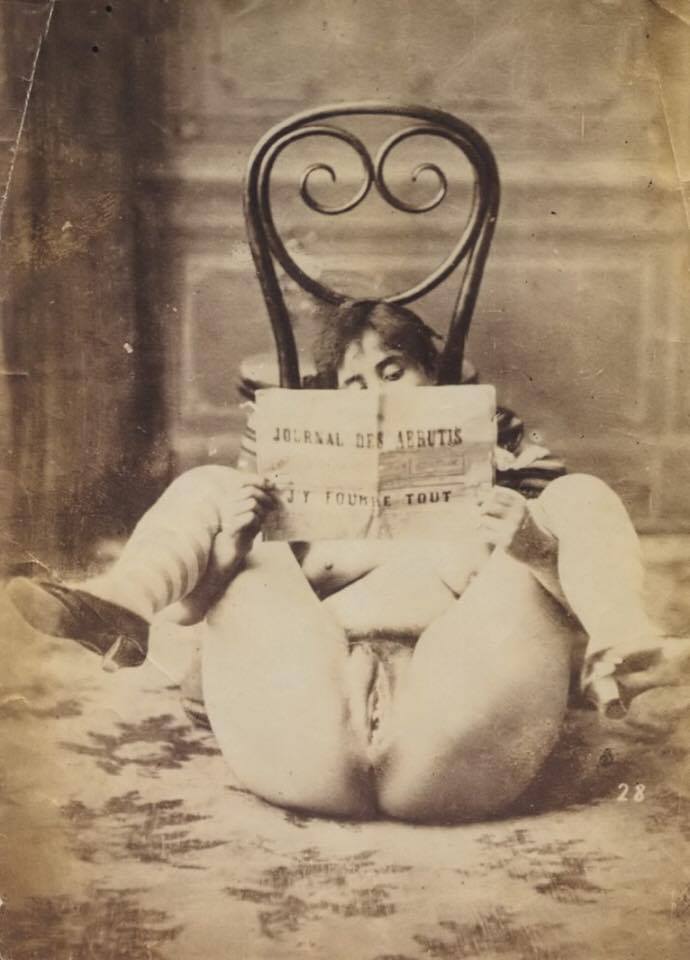

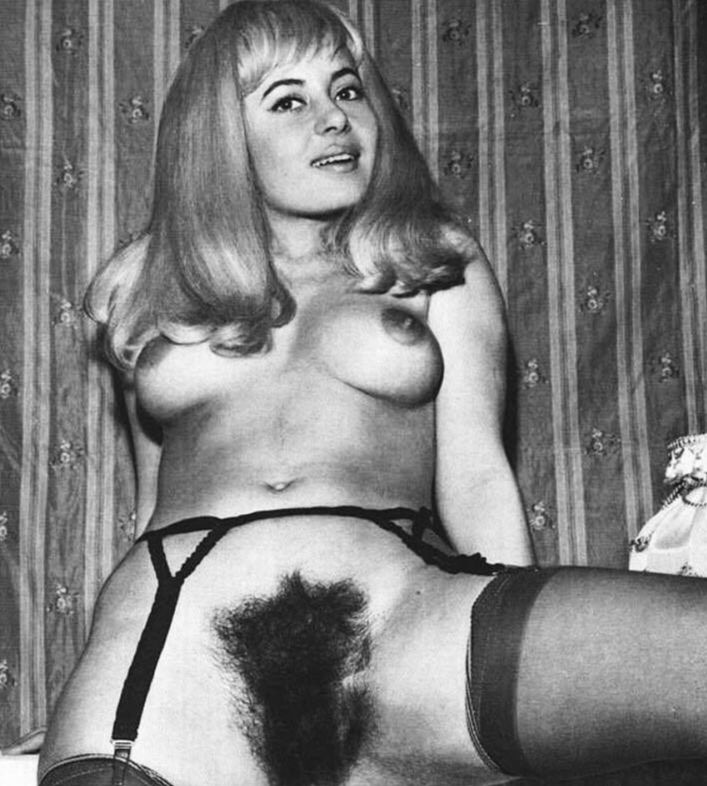

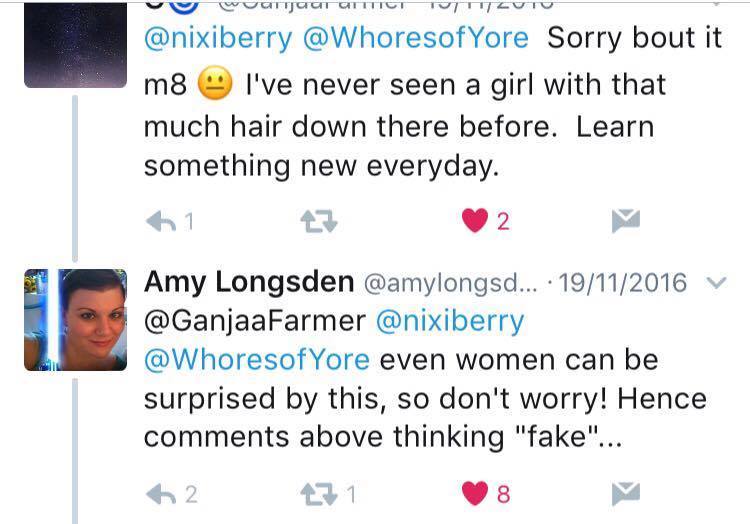




 RSS Feed
RSS Feed